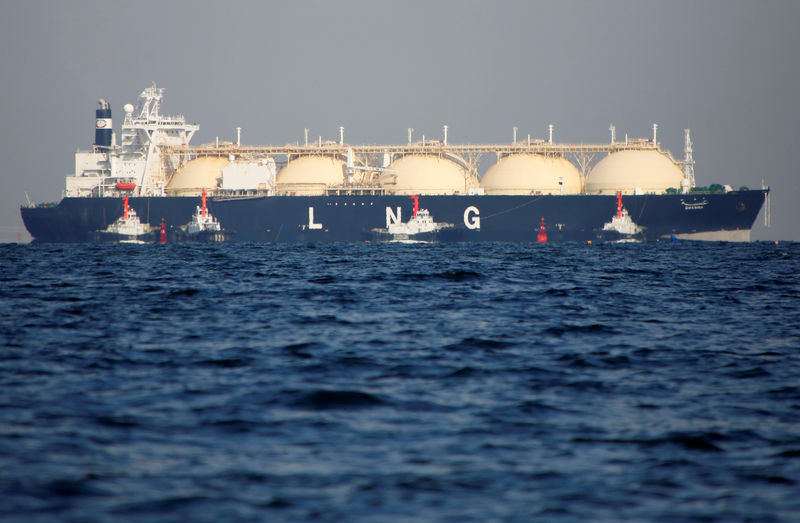By Jessica Jaganathan and Henning Gloystein
NUSA DUA, Indonesia/SINGAPORE (Reuters) - Soaring gas demand from China, India and Southeast Asia is sucking up an LNG supply glut previously expected to last for years, opening opportunity for new production from East Africa to North America that had been deemed part of the overhang.
Trade flows in Eikon show global liquefied natural gas (LNG) imports have risen 40 percent since 2015, to almost 40 billion cubic meters (bcm) a month. Growth accelerated in 2017, with imports up by a fifth, largely due to China, but also South Korea and Japan.
Asia's LNG market has been glutted since 2015, following massive development that began in the early 2000s. But a gasification program in China last year and strong economic growth across Asia pushed up demand, contributing - along with a cold winter - to a doubling of LNG spot prices from mid-2017.
The market is expected to remain relatively tight for the remainder of 2018, with China's gas program continuing and delays at several export projects.
"The tight market is going to continue simply because demand is growing and expected projects have been delayed," said Jun Nishizawa, senior vice president at the energy division of Japan's Mitsubishi Corp's.
Nishizawa cited delays in projects at Cameron LNG export terminal in Louisiana, in which Mitsubishi has a stake, and Freeport LNG in Texas.
Freeport's first LNG train is scheduled to be completed in November 2018 and no delays have been announced.
"I don't think substantial LNG will be produced by these two projects by end of the year," Nishizawa said, speaking at an LNG industry conference last week in Bali, Indonesia.
In Australia, the Ichthys project developed by Japan's Inpex and France's Total has seen several delays and cost blowouts. Total's CEO said first exports now may not come until the second quarter.
The LNG tanker market is also tight, with few ships ordered in recent years.
"The global LNG tanker market looks increasingly bullish for 2018 and 2019, as strong demand growth and a thinning order-book pressure the available supply," BMI Research said this week.
CHANCE FOR NEW PROJECTS
This unexpected tightening potentially opens the way for new projects for the first time in several years.
Many projects were delayed or axed when oil and gas prices started tumbling in mid-2014. Now energy companies are returning to health as prices have improved.
"The entire Asian LNG market will increase. It will stimulate more producers to take the risk to develop projects to get into Asia," said Jarand Rystad, chief executive of consultancy Rystad Energy.
In East Africa, U.S. energy firm Anadarko Petroleum (NYSE:APC) is getting closer to a final investment decision (FiD) as it lines up potential buyers for its Mozambique gas field.
Tokyo Gas is the latest to near an offtake agreement, according to three sources with direct knowledge of the matter, who asked not to be named as they could not talk about ongoing contractual negotiations.
Anadarko and Tokyo Gas declined to comment.
Anadarko's Mozambique concession holds an estimated 75 trillion cubic feet (2.1 trillion cubic meters) of gas, its website says, four times 2017's globally imported LNG volumes.
Several export projects in North America also hope for FiD this year.
They include LNG Canada, or Kitimat, a $40 billion, 6.5 million-tonnes-a-year venture involving Royal Dutch Shell (LON:RDSa), PetroChina, Korea Gas Corporation and Japan's Mitsubishi.
In the United States, Cheniere Energy plans to expand, and Pembina Pipeline hopes for FiD on its 7.8 million-tonne-a-year Jordan Cove plant in Oregon.
Also, top LNG exporter Qatar plans to expand output to over 100 million tonnes a year by 2024, from 77 million tonnes now.
Other projects and expansions are planned from West Africa to Papua New Guinea.
Just a few of these projects would lift specialist LNG firms like Norway's Hoegh LNG.
"Now that they (China) are setting up (import) terminals, more demand could emerge," said Parth Jindal, managing director of Hoegh LNG Asia.
One risk to new projects, though, are emerging price disputes between buyers and sellers, with importers demanding cheaper and more flexible terms.
Poten and Partners, an energy brokerage and consultancy, said this week a "dearth of commitments" from buyers to long-term contracts would make it hard for developers to finance new capacity.
NEW DEMAND
North Asia has been anchoring demand for the past decade - Japan, China and South Korea being the top three LNG importers - with China accounting for most of the growth.
South and Southeast Asia are now providing new demand.
India is starting a gas development program that could match China's, planning to add 11 LNG import terminals to an existing four..
Pakistan started importing LNG in 2015 and has ambitious expansion plans. Bangladesh and Myanmar also plan to develop import terminals.
Thailand expects its LNG imports to climb nearly sevenfold, to 35 million tonnes a year by 2036, and Indonesia, the world's fifth-biggest LNG exporter, is expected to become a net importer as domestic production stalls.

By 2030, Thailand and Indonesia together could import nearly 70 million tonnes of LNG a year, said Azam Mohammad of consultancy McKinsey, comparable to all the gas China imported in 2017.